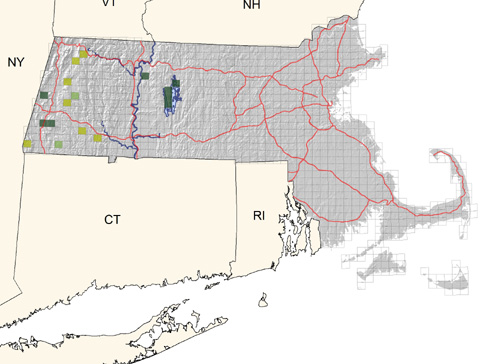Breeding Bird Atlases (BBA)
Find a Bird - BBA1
Breeding Bird Atlas 1 Species Accounts
Wild Turkey
Meleagris gallopavo
Egg Dates
April 24 to May 31
Number of Broods
one; may re-lay if first attempt fails.

The Wild Turkey was extirpated from Massachusetts by 1851 due to widespread clearing of the forests and market hunting. Between 1911 and 1967, about 350 to 380 turkeys were released in Massachusetts during nine restoration attempts. These failed, due principally to the lack of heritable wildness for the pen-raised birds. In 1972 to 1973, 37 wild-trapped New York turkeys were released in Berkshire County. An established population of 4,000 turkeys now occurs west of the Connecticut River, and transplants (162 birds, 1979 to 1984) east of the river are furthering this bird’s range expansion.
Turkeys are nonmigratory. Eastern Wild Turkeys may move up to 12 miles between summer and winter habitat; however, movements of less than 5 miles are more typical. Eastern turkeys are commonly associated with mature hardwood forests containing an abundance of mast trees but have adapted to less mature and more diverse mixtures of forest and open habitats. Brood range typically includes grassy clearings and forest openings, usually near a water source.
Turkeys have no song but produce a distinct repertoire of vocalizations including the gobble, yelp, putt, cluck, purr, cackle, and whistle, which variously function in mating, brood assembly, and flock alertness. As daylight hours lengthen, hormonal changes induce gonadal enlargement, gobbling, and display among adult males. Juvenile males are capable of breeding but may not do so due to intimidation by the dominant adults. The males are promiscuous and will breed with several hens. They display weak territoriality, and toms may fight by shoving and spurring each other. Gobbling is high at the onset of breeding, drops off as hens start nesting, and peaks again when most hens are on the nest and males are still sexually active.
Turkeys nest on the ground in a shallow, leaf-lined depression, often in abandoned fields, slash areas, or forest openings. Completed clutches averaged twelve in Massachusetts. Nesting success averages 55 percent. The precocial young are brooded at night by the hen until they can fly to roost at about two weeks of age. Poults usually feed heavily on protein-rich insects for the first several weeks of life, switching to nuts, fruits, seeds, and herbs thereafter. Poult mortality may be high, with the greatest losses usually occurring within the first two weeks after hatching. Survival of poults averages 38 percent until two weeks of age and 23 percent throughout the summer.
During summer and early fall, hens and broods remain in or near fields, grasslands, or savannahs. Usually, flocks consist of one or two hens and their combined broods. By late fall, the birds are frequenting hardwood ridges, and the young males usually split off to form bachelor flocks. Adult males similarly remain segregated. Depending on habitat, snow depths, and food availability, winter flocks may reach or exceed 100 birds. These consist largely of hens, but males may form temporary attachments. The large flocks are unstable and may separate and reform repeatedly. South-facing slopes, spring seepages, and farmland are preferred winter habitat. Flock breakup usually occurs in mid- to late March, following the onset of mating behavior.
Map Legend and Data Summary
Atlas 1 data collected from 1975-1979


Note: uncommon at Quabbin Reservoir and the Berkshires; rapidly increasing in other locations due to transplants from the western Massachusetts population
James E. Cardoza



